
An oil refinery or petroleum refinery is an industrial process plant where petroleum is transformed and refined into products such as gasoline (petrol), diesel fuel, asphalt base, fuel oils, heating oil, kerosene, liquefied petroleum gas and petroleum naphtha. Petrochemical feedstock like ethylene and propylene can also be produced directly by cracking crude oil without the need of using refined products of crude oil such as naphtha. The crude oil feedstock has typically been processed by an oil production plant. There is usually an oil depot at or near an oil refinery for the storage of incoming crude oil feedstock as well as bulk liquid products. In 2020, the total capacity of global refineries for crude oil was about 101.2 million barrels per day.

Piper Alpha was an oil platform located in the North Sea about 120 miles (190 km) north-east of Aberdeen, Scotland. It was operated by Occidental Petroleum (Caledonia) Limited (OPCAL) and began production in December 1976, initially as an oil-only platform, but later converted to add gas production.

The Flixborough disaster was an explosion at a chemical plant close to the village of Flixborough, North Lincolnshire, England, on 1 June 1974. It killed 28 and seriously injured 36 of the 72 people on site at the time. The casualty figures could have been much higher if the explosion had occurred on a weekday, when the main office area would have been occupied. A contemporary campaigner on process safety wrote "the shock waves rattled the confidence of every chemical engineer in the country".
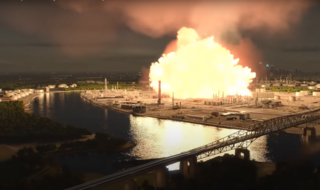
A boiling liquid expanding vapor explosion is an explosion caused by the rupture of a vessel containing a pressurized liquid that is or has reached a temperature sufficiently higher than its boiling point. Because the boiling point of a liquid rises with pressure, the contents of the pressurized vessel can remain a liquid as long as the vessel is intact. If the vessel's integrity is compromised, the loss of pressure drops the boiling point, which can cause the liquid to convert to gas expanding rapidly. BLEVEs are manifestations of explosive boiling.
Process Safety Managementof Highly Hazardous Chemicals is a regulation promulgated by the U.S. Occupational Safety and Health Administration (OSHA). It defines and regulates a process safety management (PSM) program for plants using, storing, manufacturing, handling or carrying out on-site movement of hazardous materials above defined amount thresholds. Companies affected by the regulation usually build a compliant process safety management system and integrate it in their safety management system. Non-U.S. companies frequently choose on a voluntary basis to use the OSHA scheme in their business.

The Texas City refinery explosion occurred on March 23, 2005, when a flammable hydrocarbon vapor cloud ignited and violently exploded at the isomerization process unit of the BP oil refinery in Texas City, Texas, killing 15 workers, injuring 180 others and severely damaging the refinery. All the fatalities were contractors working out of temporary buildings located close to the unit to support turnaround activities. Property loss was $200 million. When including costs of repairs, deferred production, fines and settlements, the explosion is the world's costliest refinery accident.
In the chemical and process industries, a process has inherent safety if it has a low level of danger even if things go wrong. Inherent safety contrasts with other processes where a high degree of hazard is controlled by protective systems. As perfect safety cannot be achieved, common practice is to talk about inherently safer design. “An inherently safer design is one that avoids hazards instead of controlling them, particularly by reducing the amount of hazardous material and the number of hazardous operations in the plant.”
Longford is a town in the Gippsland region of Victoria, Australia. According to the 2006 census, Longford and the surrounding area had a population of 929.
Trevor Asher Kletz, OBE, FREng, FRSC, FIChemE was a prolific British author on the topic of chemical engineering safety. He was a central figure in establishing the discipline of process safety. He is credited with introducing the concept of inherent safety and was a major promoter of Hazop. He is listed in The Palgrave Dictionary of Anglo-Jewish History.

The U.S. Chemical Safety and Hazard Investigation Board (USCSB), generally referred to as the Chemical Safety Board (CSB), is an independent U.S. federal agency charged with investigating industrial chemical accidents. Headquartered in Washington, D.C., the agency's board members are appointed by the president and confirmed by the United States Senate. The CSB conducts root cause investigations of chemical accidents at fixed industrial facilities.
ExxonMobil Australia is an Australian affiliate of ExxonMobil, the U.S.-based oil giant. It operates a number of oil and gas platforms in Bass Strait, south east of Melbourne, Australia, as well as a gas processing facility at Longford and Long Island Point (LIP) in Hastings.
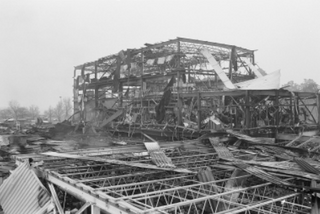
The West Pharmaceutical Plant explosion was an industrial disaster that occurred on January 29, 2003 at the West Pharmaceutical Plant in Kinston, North Carolina, United States. Six people were killed and thirty-six people were injured when a large explosion ripped through the facility. Two firefighters were injured in the subsequent blaze. The disaster occurred twelve years and 170 miles (270 km) from the 1991 Hamlet chicken processing plant fire, North Carolina's second-worst industrial disaster.
Process safety is an interdisciplinary engineering domain focusing on the study, prevention, and management of large-scale fires, explosions and chemical accidents in process plants or other facilities dealing with hazardous materials, such as refineries and oil and gas production installations. Thus, process safety is generally concerned with the prevention of, control of, mitigation of and recovery from unintentional hazardous materials releases that can have a serious effect to people, plant and/or the environment.
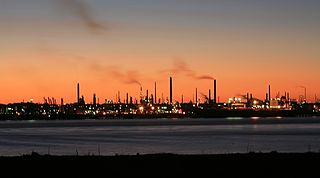
Fawley Refinery is an oil refinery located at Fawley, Hampshire, England. The refinery is owned by Esso Petroleum Company Limited, a subsidiary of Exxon Mobil Corporation, which acquired the site in 1925. Situated on Southampton Water, it was rebuilt and extended in 1951 and is now the largest oil refinery in the United Kingdom, and one of the most complex refineries in Europe. With a capacity of 270,000 barrels (43,000 m3) per day, Fawley provides 20 per cent of the UK's refinery capacity. Over 2,500 people are employed at the site.
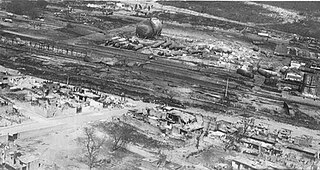
The San Juanico disaster involved a series of fires and explosions at a liquefied petroleum gas (LPG) tank farm in the settlement of San Juan Ixhuatepec, municipality of Tlalnepantla de Baz, State of Mexico, Mexico on 19 November 1984. The facility and the settlement, part of Greater Mexico City, were devastated, with 500–600 victims killed, and 5000–7000 suffering severe burns. It is one of the deadliest industrial disasters in world history, and the deadliest industrial accident involving fires and/or explosions from hazardous materials in a process or storage plant since the Oppau explosion in 1921.
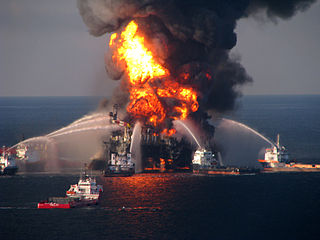
Energy resources bring with them great social and economic promise, providing financial growth for communities and energy services for local economies. However, the infrastructure which delivers energy services can break down in an energy accident, sometimes causing considerable damage. Energy fatalities can occur, and with many systems deaths will happen often, even when the systems are working as intended.
The AcciMap approach is a systems-based technique for accident analysis, specifically for analysing the causes of accidents and incidents that occur in complex sociotechnical systems.

A domino effect accident is an accident in which a primary undesired event sequentially or simultaneously triggers one or more secondary undesired events in nearby equipment or facilities, leading to secondary accidents more severe than the primary event. Thus, a domino effect accident is actually a chain of multiple events, which can be likened to a falling row of dominoes. The term knock-on accident is also used.
An explosion at the ARCO Chemical (ACC) Channelview, Texas petrochemical plant killed 17 people and injured five others on July 5, 1990. It was one of the deadliest industrial disasters in the history of the Greater Houston area.













